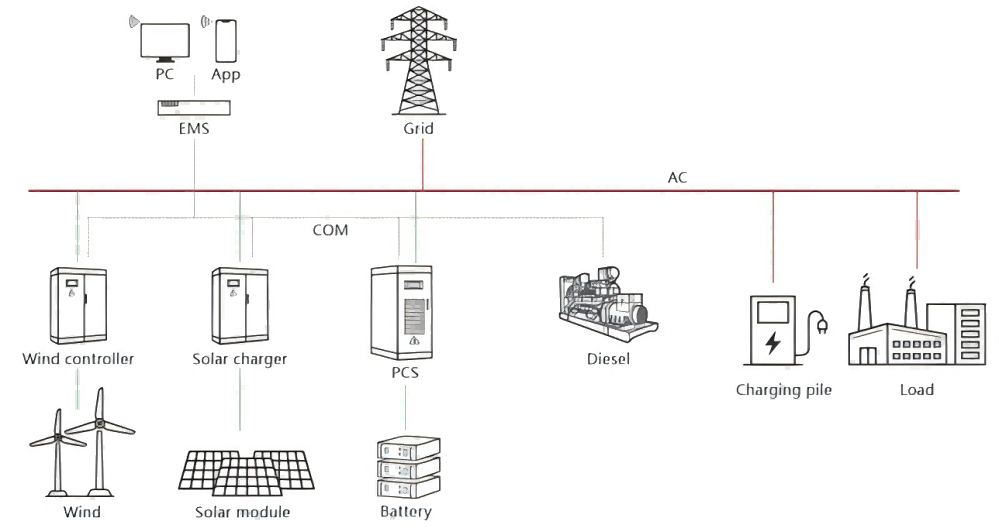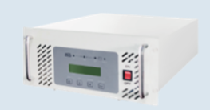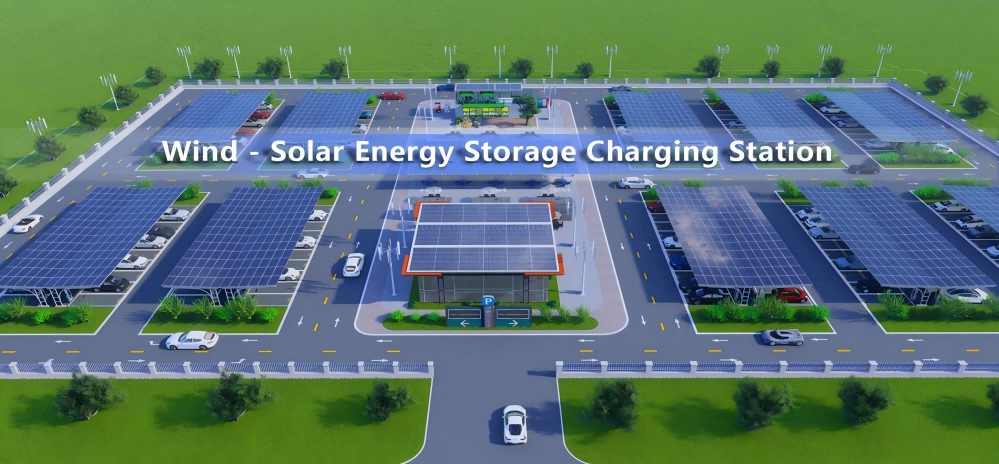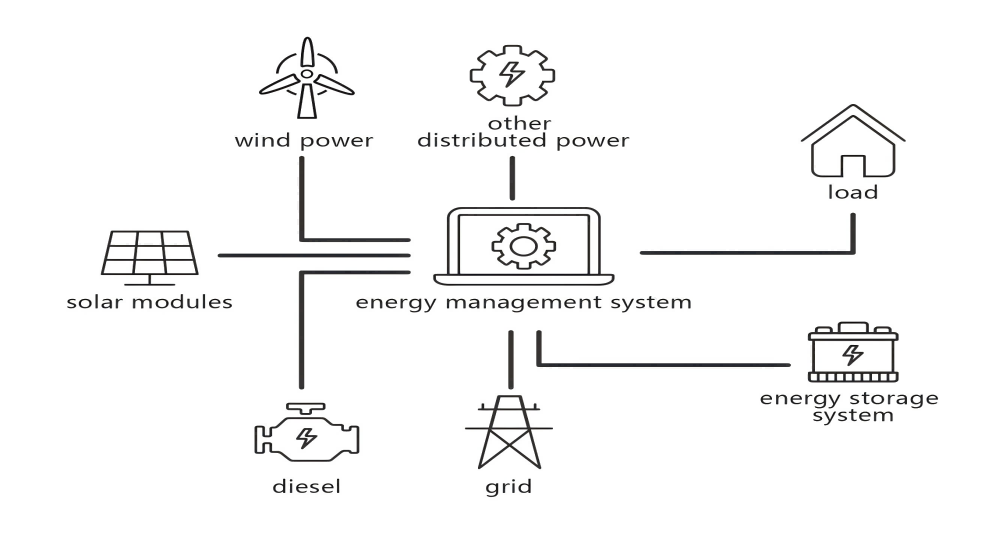What is Micro-grid system?
Micro-grid System Overview:
A compact distribution system featuring distributed power sources, energy storage, energy converters, loads, and monitoring/protection devices.
Primary power sources include photovoltaic (PV) panels, wind turbines, diesel generators, and other power generator units.
Key configurations are solar-storage, wind-solar-storage, and wind-solar-diesel-storage systems.
Micro-grid Principles:
A versatile system with capacity ranging from hundreds of watts to megawatts, and energy storage from hundreds of watt-hours to megawatt-hours.
System Features: Adaptable configurations, non-standardized products, varied customer needs, high technical service demands, requiring robust technical expertise from the company.
Classification of Microgrid Systems:
DC Micro-Grid System
AC Micro-Grid System


Core Technologies in Microgrid Systems:
PCS (Power Conversion System) Technology

An Energy Storage converter (ESI) is a key device used in an energy storage system that converts direct current (DC) stored in a battery into alternating current (AC) for transmission to the grid or supply load. It plays a vital role in photovoltaic (PV) systems, battery energy storage systems (BESS) and other applications.
The main functions of the energy storage converter include:
DC-AC conversion: Converts direct current in the energy storage battery to alternating current for easy connection with the grid or load.
Battery charge and discharge management: By controlling the charge and discharge process of the battery, ensure the health of the battery and extend the battery life.
Power control: According to the demand and system status, adjust the output power to meet different load requirements or the needs of the grid.
Grid-connected function: In some systems, the energy storage converter can feed the electric energy stored by the battery to the grid as a regulatory source of the grid to help balance the grid load, especially in the case of high volatility of renewable energy.
System protection: Provides protection functions such as overcurrent, overtemperature, and short circuit to ensure safe and stable system operation.
Solar Charging Technology
A Solar Charge Controller is a device used in a solar photovoltaic system whose main role is to manage the charging process between the electricity generated by the photovoltaic module and the battery. By adjusting the charging current and voltage of the battery, it ensures that the battery is charged in the best condition, while avoiding overcharging, overdischarging or damaging the battery.
Main functions of PV charging control module:
Current and voltage regulation between solar panels and batteries:

The PV charging controller is able to convert the direct current generated by the PV module into the current and voltage suitable for battery charging.
It adjusts the output according to the charging state of the battery to prevent the battery from overcharging or overdischarging.
Maximum Power Point Tracking (MPPT) features:
Some high-end PV charging control modules are equipped with maximum power point tracking (MPPT) technology, which can adjust the operating voltage of the photovoltaic panel in real time to ensure its maximum power output.
Compared with the traditional PWM (pulse width modulation) controller, the MPPT controller is more efficient and can effectively improve the overall power generation efficiency of the photovoltaic system.
Battery protection function:
Prevent battery overcharge: When the battery is full, the charge controller will automatically stop charging to prevent battery damage.
Prevent battery overdischarge: When the battery voltage is too low, the controller will stop discharging to protect the battery from damage.
Provides over temperature and over current protection functions to ensure safe and stable system operation.
Multiple charging modes:
Photovoltaic charging controllers usually support different charging modes, such as constant voltage charging, constant current charging, trickle charging, etc., to adapt to the needs of different types of batteries.
Some controllers support automatic adjustment of charging parameters based on battery type (such as lead-acid batteries, lithium batteries, etc.).
Load control:
Some charging control modules can also control the access of the load to ensure the stability of the battery during the charging process.
If the load current is too large, the controller cuts off the load to avoid excessive battery discharge.
LED or digital display interface:
The control module is usually equipped with an LED indicator or a digital display to display the current charging status, battery level, working mode and other information.
Anti-reverse connection protection:
Some controllers also provide anti-reverse battery and solar panel protection to avoid damage caused by the wrong power supply.
BMS (Battery Management System)
Charge management: Control the charging process according to the SOC (State of Charge) of the battery. Avoid overcharge or overdischarge to extend battery life.
Charging strategy: Depending on the type of battery (such as lithium battery, lead-acid battery, etc.), BMS will select the appropriate charging curve (such as constant current, constant voltage, trickle mode, etc.) to optimize the charging process.
Battery balance:
Passive equalization: Balancing the voltage of individual cell cells by consuming excess charge, commonly seen in low-cost BMS systems.
Active equalization: The transfer of charge from a battery cell with a higher voltage to a battery cell with a lower voltage by means of energy transfer, thereby improving the overall efficiency of the system, commonly seen in high-end systems.
Battery health Monitoring:
Health status assessment: BMS estimates the battery's SOH (State of Health) by recording the battery's charge and discharge history and parameter changes. This helps to predict the remaining life of the battery.
Fault detection and alarm: The BMS can detect the fault of the battery cell or battery pack, such as the battery voltage is too low, the current is too high, or the temperature is abnormal, and notify the user or the system through the alarm mechanism.
State estimation and management:
SOC (State of Battery Charge) : Indicates the percentage of the battery's current charge, similar to the charge indicator on a mobile phone. BMS estimates SOC by measuring parameters such as voltage, current, and temperature.
SOH (Battery Health Status) : Indicates the health of the battery, reflecting the degree of battery capacity decay.
SOP (Battery Protection Status) : Monitors whether the battery is in safe working condition to prevent overload.
Battery protection:
Overcharge protection: If the battery cell voltage exceeds the set safe value, the BMS will stop charging to prevent battery damage or danger.
Overdischarge protection: When the battery voltage is too low, the BMS will cut off the discharge to prevent the battery from being damaged due to excessive discharge.
Overcurrent protection: If the charge and discharge current exceeds the set safe value, BMS will take measures to cut off the current and prevent battery damage.
Short circuit protection: Prevent short circuit of the battery pack to avoid possible fire or explosion risk.
Communication function:
BMS usually communicates with external devices through the CAN bus or other communication protocols to transmit the status information of the battery pack in real time, including battery voltage, temperature, current, SOC, SOH and other parameters.
This data can be captured by monitoring centers, vehicle control systems, or charging devices for system management and decision making.
Common Aplication Scenarios









